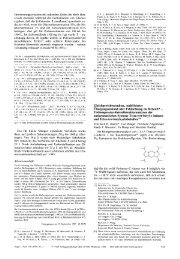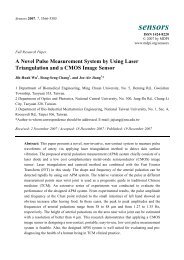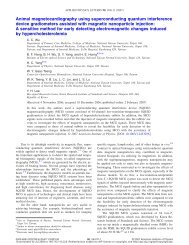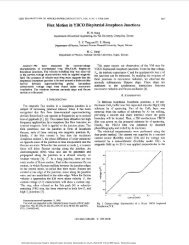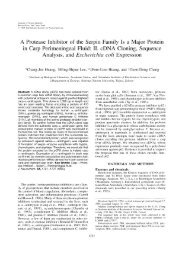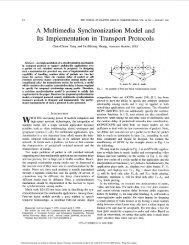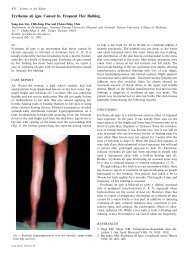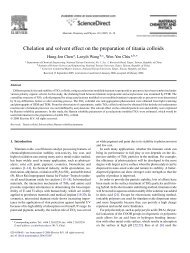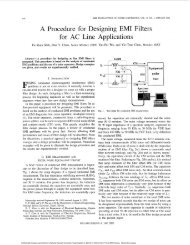Coexistence of Epilepsy and Myasthenia Gravis: Report of Four ...
Coexistence of Epilepsy and Myasthenia Gravis: Report of Four ...
Coexistence of Epilepsy and Myasthenia Gravis: Report of Four ...
Create successful ePaper yourself
Turn your PDF publications into a flip-book with our unique Google optimized e-Paper software.
181<br />
<strong>Coexistence</strong> <strong>of</strong> <strong>Epilepsy</strong> <strong>and</strong> <strong>Myasthenia</strong> <strong>Gravis</strong>:<br />
<strong>Report</strong> <strong>of</strong> <strong>Four</strong> Patients <strong>and</strong> Review <strong>of</strong> the Literature<br />
Jen-Jen Su, Ming-Jang Chiu, <strong>and</strong> Yang-Chyuan Chang<br />
Abstract- Patients with myasthenia gravis (MG) have a higher incidence <strong>of</strong> epilepsy or seizure disorders<br />
than general population. <strong>Coexistence</strong> <strong>of</strong> MG <strong>and</strong> epilepsy seems not simply due to chance association. MG<br />
was not infrequently considered as a complication <strong>of</strong> long-term anticonvulsant therapy. In National Taiwan<br />
University Hospital, we found 4 out <strong>of</strong> 251 MG patients who suffered from epilepsy. MG manifestations <strong>of</strong><br />
these patients did not differ from those in MG patients without epilepsy. There were increased levels <strong>of</strong> antibody<br />
to acetylcholine receptors <strong>and</strong> association with thymus hyperplasia or thyroid disease. In the literature,<br />
we found 25 reported cases with MG <strong>and</strong> epilepsy. No specific type <strong>of</strong> epilepsy was linked to coexistence <strong>of</strong><br />
MG <strong>and</strong> epilepsy. Possible causes for MG in association with epilepsy are multiple, including drug-induced<br />
depression at the neuromuscular junction, anticonvulsant-related immunological changes, <strong>and</strong> unknown<br />
common mechanism to both diseases.<br />
Key Words: <strong>Myasthenia</strong> gravis, <strong>Epilepsy</strong>, Anticonvulsants<br />
Acta Neurol Taiwan 2003;12:181-186<br />
INTRODUCTION<br />
In 1916, Fearnsides described a woman with epilepsy<br />
who developed myasthenia gravis (MG) 3 years after<br />
the onset <strong>of</strong> epilepsy (1) . He did not infer any causal relation<br />
between these two diseases. In 1953, Pages <strong>and</strong><br />
Passouant mentioned a male patient who also had both<br />
epilepsy <strong>and</strong> MG, but his MG problems occurred 14<br />
years before the onset <strong>of</strong> epilepsy (2) . In 1958, Hoefer et<br />
al. reported 8 MG patients in association with epilepsy<br />
or seizure disorders <strong>and</strong> noted for the first time a significantly<br />
high incidence <strong>of</strong> epilepsy in MG patients (3) . In<br />
1964, Norris et al. reported 3 epileptic patients with<br />
phenytoin overdose who developed disordered neuromuscular<br />
transmission (4) . They also demonstrated a toxic<br />
effect <strong>of</strong> phenytoin on the neuromuscular junction in rat<br />
experiments. Thereafter, cases with MG <strong>and</strong> epilepsy<br />
were sporadically reported (5-16) . As MG manifestations in<br />
these patients usually developed during long-term anticonvulsant<br />
therapy <strong>and</strong> remitted or improved significantly<br />
after changing anticonvulsant, MG was thought<br />
to be a complication <strong>of</strong> anticonvulsant therapy (9,15,17,18) . In<br />
this report, we described four Taiwanese patients with<br />
coexistence <strong>of</strong> MG <strong>and</strong> epilepsy, <strong>and</strong> reviewed literature<br />
From the Department <strong>of</strong> Neurology, National Taiwan<br />
University Hospital, Taipei, Taiwan.<br />
Received April 11, 2003. Revised May 20, 2003.<br />
Accepted July 10, 2003.<br />
Reprint requests <strong>and</strong> correspondence to: Yang-Chyuan Chang,<br />
MD. Department <strong>of</strong> Neurology, National Taiwan University<br />
Hospital, No. 7, Chung-Shan South Road, Taipei, Taiwan.<br />
E-mail: ycchang@ha.mc.ntu.edu.tw<br />
Acta Neurologica Taiwanica Vol 12 No 4 December 2003
182<br />
to find the association between these two neurological<br />
disorders.<br />
CASE REPORTS<br />
Case 1<br />
SLC, a 46-year-old woman, had several episodes <strong>of</strong><br />
generalized tonic-clonic convulsions at the age <strong>of</strong> 4. She<br />
received anticonvulsant therapy for 1 year <strong>and</strong> had had<br />
no seizures until the age <strong>of</strong> 16 when she had recurrence.<br />
The seizures were described as sudden head turning <strong>and</strong><br />
eye deviation to the right side for 15-25 seconds, followed<br />
by loss <strong>of</strong> consciousness <strong>and</strong> generalized tonicclonic<br />
convulsions for 1-2 minutes. On neurological<br />
examination, there were no abnormal findings. An<br />
awake EEG revealed focal epileptiform discharges in the<br />
left frontal region but isotope brain scans failed to disclose<br />
abnormal uptake. She began to receive combined<br />
phenobarbital (40~80 mg/day) <strong>and</strong> phenytoin (100~200<br />
mg/day) therapy. Her compliance was not adequate so<br />
that she had occasional attacks, about once or twice a<br />
year between the ages <strong>of</strong> 16 <strong>and</strong> 33 years. She had complained<br />
<strong>of</strong> mild intermittent weakness <strong>of</strong> the upper limbs<br />
for 2 years since she was 33 years old. The weakness<br />
was found most frequently during hair combing <strong>and</strong><br />
occasionally h<strong>and</strong> grasping. However, there was neither<br />
muscle atrophy nor hyporeflexia. Cranial nerves, coordination,<br />
sensations, <strong>and</strong> sphincter functions were normal,<br />
whereas repetitive 3-Hz electric stimulation revealed<br />
decremental responses at the right deltoid muscle. The<br />
chest computed tomography (CT) showed thymic<br />
enlargement. Treatment with pyridostigmine bromide<br />
alleviated her weakness. She then received thymectomy,<br />
<strong>and</strong> the pathology revealed lymphoid hyperplasia. After<br />
operation, her weakness disappeared gradually <strong>and</strong> pyridostigmine<br />
was discontinued within 3 months. She<br />
refused to take anticonvulsants in spite <strong>of</strong> occasional<br />
epileptic attacks. The muscle weakness has since not<br />
recurred.<br />
Case 2<br />
SCC, a 57-year-old man, suffered from a severe head<br />
injury in a traffic accident when he was 26 years old. At<br />
that time, he remained unconscious for 1 week <strong>and</strong><br />
stayed in a hospital for 3 weeks. Seven months later, the<br />
patient developed several episodes <strong>of</strong> nocturnal tonicclonic<br />
convulsions <strong>and</strong> was brought to our hospital for<br />
further work-up. On examination, there were no abnormal<br />
physical or neurological signs. An awake EEG<br />
revealed an epileptogenic focus at the right anterior temporal<br />
region. Under the diagnosis <strong>of</strong> post-traumatic<br />
epilepsy, anticonvulsant therapy with phenobarbital<br />
(80mg/day) <strong>and</strong> phenytoin (200 mg/day) was started. A<br />
follow-up EEG at the age <strong>of</strong> 34 still disclosed focal<br />
spikes in the bilateral temporal regions, although his<br />
epilepsy was kept under control. Anticonvulsants were<br />
gradually tapered 7 years later <strong>and</strong> totally discontinued<br />
when he was 37 years old.<br />
At the age <strong>of</strong> 34, the patient suffered from intermittent<br />
bilateral ptosis, which could be alleviated by an<br />
intramuscular injection <strong>of</strong> neostigmine methylsulfate. A<br />
clinical diagnosis <strong>of</strong> ocular myasthenia gravis was made.<br />
However, his ptosis did not respond to pyridostigmine<br />
<strong>and</strong> double vision occasionally supervened. At his age <strong>of</strong><br />
35, the patient received an alternate-day high-dose<br />
(100mg) prednisolone. The ptosis <strong>and</strong> double vision disappeared<br />
completely within 1 month but he refused further<br />
steroid therapy because <strong>of</strong> the its side effects.<br />
Intermittent ptosis <strong>and</strong> double vision recurred half a year<br />
later. He gradually adapted to the ocular problems <strong>and</strong><br />
gave up all anti-MG medications at the age <strong>of</strong> 37.<br />
At the age <strong>of</strong> 38, about one <strong>and</strong> a half years after discontinuing<br />
anticonvulsant therapy, the generalized tonicclonic<br />
convulsions recurred. The patient was again prescribed<br />
phenytoin (300 mg/day) for seizure control. At<br />
the same time, his eye problems remained stationary for<br />
2 years. However, ptosis <strong>and</strong> double vision worsened<br />
when he was 41 years <strong>of</strong> age. Repetitive electric stimulations<br />
at the right median <strong>and</strong> right facial nerves did not<br />
show significant decremental responses. Single fiber<br />
EMG study at the right extensor digitorum communis<br />
muscle showed a mean consecutive difference (MCD) <strong>of</strong><br />
97.7 µsec (normal
183<br />
phenytoin, but was ab<strong>and</strong>oned due to leukopenia.<br />
Valproates were not considered because <strong>of</strong> his chronic<br />
active hepatitis. Thus, phenytoin was restarted. He kept a<br />
stationary condition under phenytoin <strong>and</strong> pyridostigmine<br />
thereafter.<br />
Case 3<br />
SHC, a 33-year-old woman, had an uneventful birth<br />
<strong>and</strong> developmental history. She had her first seizure<br />
when she was 10 years old, which was manifested as<br />
sudden unawareness to the surroundings, starring for<br />
about 30 seconds, followed by automatic behaviors for 1<br />
minute. She also had urine incontinence during the<br />
attack. After EEG <strong>and</strong> neuroimaging studies were performed,<br />
a diagnosis <strong>of</strong> complex partial seizure was<br />
made. She was treated with primidone 1250 mg per day.<br />
She had no attacks after the age <strong>of</strong> 19.<br />
At the age <strong>of</strong> 23, She began to have intermittent general<br />
weakness, especially after prolonged working. The<br />
weakness was more severe in her proximal limbs <strong>and</strong><br />
easily relieved by rest. In one month or two, she further<br />
developed intermittent ptosis <strong>of</strong> left eye, dysphagia <strong>and</strong><br />
masticating difficulty. <strong>Myasthenia</strong> gravis was diagnosed<br />
<strong>and</strong> treatment with pyridostigmine <strong>and</strong> high-dose prednisolone<br />
was given but in vain. She was hospitalized at<br />
the age <strong>of</strong> 23.<br />
On admission, mild exophthalmos, ptosis <strong>and</strong> limited<br />
upward gaze were found in the left eye. Moderate<br />
weakness in the proximal parts <strong>and</strong> mild weakness in the<br />
distal parts <strong>of</strong> four limbs were detected. There was neither<br />
muscle atrophy nor hyporeflexia. Repetitive electric<br />
stimulations induced a decremental response at the right<br />
deltoid muscle, which disappeared after an intravenous<br />
administration <strong>of</strong> edrophonium. Single fiber EMG study<br />
showed an increased MCD (51.4 usec). Chest CT <strong>of</strong> the<br />
mediasternum was normal. The blood level <strong>of</strong> anti-<br />
AChR antibody was 6.24 nmole/L (normal < 0.2<br />
nmole/L). Endocrine study revealed normal thyroid<br />
functions but elevated levels <strong>of</strong> thyroglobulin antibody<br />
(1:160, normal < 1:80) <strong>and</strong> microsomal antibody<br />
(1:20480, normal < 1:80). Hashimoto disease was proved<br />
via an aspiration cytology study <strong>of</strong> the thyroid gl<strong>and</strong>.<br />
Carbamazepine was prescribed to replace primidone for<br />
seizure control <strong>and</strong> azathioprine to replace prednisolone<br />
for MG. Her muscle power then improved after an initial<br />
brief worsening.<br />
The patient suffered from recurrence <strong>of</strong> bilateral<br />
exophthalmos <strong>and</strong> double vision when she was 28 years<br />
old. After physical check-up <strong>and</strong> blood tests, Grave’s<br />
disease was diagnosed <strong>and</strong> anti-thyroid drugs were<br />
given. She became euthyroid 1 year after the treatment.<br />
For relieving her ophthalmopathy, the patient received<br />
operations three times between 28 <strong>and</strong> 30 years <strong>of</strong> age.<br />
Despite the ophthalmological operations, exophthalmos<br />
<strong>and</strong> double vision persisted.<br />
Case 4<br />
DHC, a 43-yea-old woman, began to have recurrent<br />
seizures when she was in her junior high school. The<br />
seizure manifested as a sudden transient dizzy spell for<br />
several seconds with or without subsequent GTC. An<br />
EEG revealed interictal regional epileptiform discharges<br />
over the right hemisphere with secondary generalization.<br />
She was then put under phenytoin therapy (400 mg/day).<br />
She had a rather smooth course in the following 30 years<br />
<strong>and</strong> had only one to three seizure attacks per year.<br />
However, she began to have intermittent swallowing difficulty<br />
<strong>and</strong> nasal speech at the age <strong>of</strong> 42. Intermittent<br />
double vision, right eyelid drooping <strong>and</strong> general weakness<br />
supervened half a year later. Her weakness could be<br />
relieved after rest. On routine physical <strong>and</strong> neurological<br />
examinations, the only abnormal findings were mild<br />
right ptosis <strong>and</strong> mild weakness <strong>of</strong> neck flexion. The<br />
chest CT was normal. The blood level <strong>of</strong> anti-AChR<br />
antibody was 2.91 nmol/L (normal
184<br />
Table 1 lists the reported frequencies <strong>of</strong> epilepsy in various<br />
series <strong>of</strong> MG patients. Cumulative data showed that<br />
2.0% <strong>of</strong> the MG patients had concomitant epilepsy.<br />
<strong>Coexistence</strong> <strong>of</strong> MG <strong>and</strong> epilepsy seems not simply a<br />
chance association. EEG abnormality was found in<br />
1.5~5% <strong>of</strong> the “normal” subjects (24) <strong>and</strong> epileptiform<br />
activity in 2.2~4% <strong>of</strong> the patients without seizure disorders<br />
(25,26) . Whereas EEG abnormality has been reported in<br />
around one fourth <strong>and</strong> paroxysmal EEG changes in one<br />
tenth <strong>of</strong> the MG patients (19,23,27,28) (Table 2). The higher frequency<br />
<strong>of</strong> EEG abnormalities in the MG patients than in<br />
the normal population implies a subclinical CNS<br />
involvement (29) . The fact that MG patients had a higher<br />
incidence <strong>of</strong> paroxysmal EEG changes than the normal<br />
control is in good accordance with a higher frequency <strong>of</strong><br />
epilepsy in MG. In review <strong>of</strong> the literature, we found 25<br />
Table 1. Frequency <strong>of</strong> epilepsy in MG patients in various series<br />
Total patients <strong>Epilepsy</strong> cases %<br />
Mortier, et al. (21) 1,969 37 1.9<br />
Nozawa, et al. (19) 41 1 2.4<br />
Snead, et al. (22) 32 4 12.5<br />
Tartara, et al. (23) 118 2 1.7<br />
Rodriguez, et al. (21) 149 4 2.7<br />
Su, et al. 251 4 1.6<br />
Cumulative data 2,560 52 2.0<br />
Table 2. Frequency <strong>of</strong> electroencephalographic abnormalities in<br />
MG patients in various series<br />
Total cases Abnormal EEG Paroxysmal changes<br />
Gibbs & Gibbs (27) 14 1 0<br />
Hokkanen &<br />
Toivakaka (29)<br />
92 34 19<br />
Nozawa, et al. (19) 22 11 27<br />
Tartara, et al. (23) 118 14 0<br />
Cumulative data 246 60 (24.4%) 25 (10.2% )<br />
Table 3. Clinical data in patients with myasthenia gravis <strong>and</strong> epilepsy<br />
Case Sex<br />
Age <strong>of</strong> onset<br />
Seizure type AED MG state after Other major medical conditions Case series<br />
no EPI MG before MG changing AED<br />
1 M 16 19 GTC NA NA Fearnsides (1)<br />
2 F 48 34 GTC (MG earlier than EPI) Thymus hyperplasia at autopsy Pages, et al. (2)<br />
3 F 35 45 GTC, CPS PHT NA Partial control with PHT &MG -Rx Hoefer, et al. (3)<br />
4 F 14 24 GTC PHT, PB NA Thymectomy ineffective Hoefer, et al. (3)<br />
5 F 5 18 GTC, CPS NA NA Various AED drugs with MG-Rx Hoefer, et al. (3)<br />
6 F 20 23 GTC, CPS NA Na Post-traumatic EP Hoefer, et al. (3)<br />
7 M 7 17 GTC MHT, PB NA Remission <strong>of</strong> MG under PHT <strong>and</strong> MG-Rx Hoefer, et al. (3)<br />
8 M 4 1 day GTC (MG earlier than EPI) Congenital MG respond to MG-Rx Hoefer, et al. (3)<br />
9 F 9 30 GTC PHT Improved B12 deficiency; arthritis, PHT overdose Norris, et al. (4)<br />
10 F 0.3 ? GTC PHT, PB Improved PHT overdose; decremental response (+) Norris, et al. (4)<br />
11 F 13 24 GTC PHT Improved Measles encephalitis at age 3 Regli, et al. (15)<br />
12 F 0.8 12 PM PRM NA Premature delivery but no anoxia Sigwald, et al. (36)<br />
13 F 5 8 PM, GTC PHT, PB NA Sigwald, et al. (36)<br />
14 F 9 11 PM TMD Improved Increased Ab to muscle <strong>and</strong> thymus Peterson (13)<br />
15 F 10 28 GTC PHT, PRM NS Myasthenic crisis in the puerperium Peterson (13)<br />
16 F 1.3 7.5 PM, GTC PB, TMD Improved No antimuscular but antinuclear Aby Booker, et al. (5)<br />
17 F 14 25 PM, GTC PHT, TMD Not improved MG cleared after changing MG-Rx Gilbert (7)<br />
18 F 6.5 6 PM, GTC (MG earlier than EPI) MG much improved with CBZ, PB & MG-Rx Raynaud, et al. (14)<br />
19 F 2.5 9 PM, GTC PB, PHT Not improved Electrodecremental response (+) Mortier, et al. (11)<br />
20 F 14 25 GTC PHT, PB Improved Electrodecremental response (+) Brumlik, et al. (6)<br />
21 F 15 31 GTC PHT NA Thymectomy ineffective Hansson, et al. (8)<br />
22 M 12 19 PM, GTC PB, PHT Not improved Thymectomy for thymoma Toivakaka, et al. (18)<br />
23 F 7 35 GTC PHT Improved Neuromuscular block on single fiber EMG Milonas, et al. (10)<br />
24 F 17 22 CPS PHT Improved Thymus hyperplasia <strong>and</strong> thymectomy Lai, et al. (9)<br />
25 M 12 27 CPS PHT, TMD Not improved Psoriasis vulgaris Kwan, et al. (37)<br />
26 F 16 33 GTC PHT, PB Improved Post-traumatic EPI; increased AChR Ab Su, et al.<br />
27 M 27 34 GTC, CPS PHT, PB NA Hashimoto disease: increased AChR Ab Su, et al.<br />
28 F 10 23 CPS PRM Improved Increased AChR Ab Su, et al.<br />
29 F 13 42 GTC, CPS PHT Improved Su, et al.<br />
EPI: epilepsy; AED: antiepileptic drugs; MG: myasthenia gravis; Rx: treatment; GTC: generalized tonic-clonic convulsions; PM: petit mal; CPS:<br />
complex partial seizures; SPS: simple partial seizures; PHT: phenytoin; MHT: mesantoin; PB: phenobarbital; PRM: primidone; TMD: trimethadione;<br />
AChR: acetylcholine receptor; Ab: antibody; NA: not available; NS: not significant.<br />
Acta Neurologica Taiwanica Vol 12 No 4 December 2003
185<br />
reported cases <strong>of</strong> MG patients with epilepsy or seizures.<br />
Among them, 3 patients had only single epileptic<br />
seizure.<br />
Table 3 lists clinical data <strong>of</strong> the MG patients with<br />
epilepsy in the literature including our patients. There<br />
were 6 male <strong>and</strong> 23 female patients, which corresponded<br />
well with the sex distribution <strong>of</strong> MG. Their seizures<br />
included generalized tonic-clonic convulsions, petit mal<br />
seizures, <strong>and</strong> complex partial seizures. No specific type<br />
<strong>of</strong> seizure was particularly linked to MG. Most patients<br />
listed in Table 3 had an onset <strong>of</strong> epilepsy earlier than that<br />
<strong>of</strong> MG. Thus, MG conceivably developed during anticonvulsant<br />
therapy, though MG was not necessarily a<br />
complication <strong>of</strong> the latter. In most patients, MG did<br />
remit after change or cessation <strong>of</strong> anticonvulsants (Table<br />
3), which implies a causal effect <strong>of</strong> anticonvulsants on<br />
MG.<br />
A variety <strong>of</strong> anticonvulsants including hydantoins,<br />
barbiturates, primidone, <strong>and</strong> trimethadione have been<br />
incriminated in drug-associated MG. Phenytoin has been<br />
shown to interfere the neuromuscular transmission in<br />
experimental animals (4,30) <strong>and</strong> in phenyton-treated<br />
patients (4,18) . Kaeser recognized that phenytoin was able<br />
to aggravate weakness <strong>of</strong> MG or unmask occult MG (17) .<br />
He also noticed that trimethadione could induce a<br />
reversible MG in which antithymic, antimuscular <strong>and</strong><br />
antinuclear antibodies were present (17) , which suggests an<br />
immunological basis <strong>of</strong> the anticonvulsant-associated<br />
MG (17) . In addition, pr<strong>of</strong>iles <strong>of</strong> the anticonvulsant-associated<br />
MG were not clinically or electrophysiologically<br />
different from the classical MG. There were increased<br />
blood levels <strong>of</strong> anti-AChR antibody <strong>and</strong> association with<br />
thymoma or thymic hyperplasia which might further<br />
suggest the immunological mechanism.<br />
The hypothesis that MG occurs as a result <strong>of</strong> longterm<br />
use <strong>of</strong> anticonvulsants did not always apply in MG<br />
patients with epilepsy (Table 3). As MG might occur<br />
earlier than epilepsy <strong>and</strong> MG did not always remit after<br />
change <strong>of</strong> anticonvulsants, additional mechanisms are<br />
necessary to explain the coexistence <strong>of</strong> these two diseases.<br />
<strong>Epilepsy</strong> is not primarily an immunological disorder,<br />
but immunological factors in epilepsy have been<br />
suggested (31,32) <strong>and</strong> immunological concomitants have<br />
been well reviewed (33) . Moreover, MG is primarily a disorder<br />
at the neuromuscular junction, <strong>and</strong> anti-AChR<br />
antibody has been found in the cerebrospinal fluid in<br />
experimental autoimmune MG (34) <strong>and</strong> in naturally occurring<br />
MG (35) . The EEGs <strong>of</strong> the rabbits with experimental<br />
autoimmune MG revealed paroxysmal epileptogenic discharges<br />
including spikes, sharp waves, spike- <strong>and</strong> -wave<br />
complex, <strong>and</strong> polyspike-<strong>and</strong>-wave complexes (34) . Instead<br />
<strong>of</strong> a causal relation between anticonvulsnats <strong>and</strong> MG, a<br />
common immunological mechanism causing both<br />
epilepsy <strong>and</strong> MG in the same individual could be an<br />
alternative explanation for their coexistence.<br />
In conclusion, MG in the epileptics is indistinguishable<br />
clinically from the MG not associated with epilepsy.<br />
Association <strong>of</strong> MG with epilepsy may be multi-factorial.<br />
Unmasking <strong>of</strong> an occult MG through anticonvulsantinduced<br />
neuromuscular depression, a de novo MG triggered<br />
by drug-related immunological disturbances, <strong>and</strong><br />
an unknown common immune mechanism causing both<br />
diseases are all possible factors for the coexistence <strong>of</strong><br />
MG <strong>and</strong> epilepsy. However, more immunological studies<br />
are necessary to support the hypothesis <strong>of</strong> immunological<br />
bases in epileptogenicity (37) .<br />
REFERENCES<br />
1. Fearnsides EG. <strong>Myasthenia</strong> gravis <strong>and</strong> epileptiform attacks<br />
observed over a period <strong>of</strong> 11 years. Proc R Soc Med 1915;<br />
9:47-9.<br />
2. Pages P, Passpiant P. Myasthenie d’Erb; Enervation sinucarotidienne;<br />
epilepsie secondaire; mort six ans après lintervention.<br />
Rev Neurol (Paris) 1953;88:112-8.<br />
3. Hoefer PFA, Aranow H Jr, Rowl<strong>and</strong> LP. <strong>Myasthenia</strong> gravis<br />
<strong>and</strong> epilepsy. Arch Neurol Psychiat 1958;80:10-7.<br />
4. Norris FH, Colella JAB, McFarlin D. Effect <strong>of</strong> diphenylhydantoin<br />
on neuromuscular synapse. Neurology 1964;14:<br />
869-76.<br />
5. Booker HE, Chun RM, Sanguino M. <strong>Myasthenia</strong> gravis<br />
syndrome associated with trimethadione. JAMA 1970;212:<br />
2262-3.<br />
6. Brumlik J, Jacobs RS. <strong>Myasthenia</strong> gravis associated with<br />
diphenylhydatoin therapy for epilepsy. Can J Neurol Sci<br />
1974;1:127-9.<br />
7. Gilbert GJ. <strong>Myasthenia</strong> gravis <strong>and</strong> epilepsy. J Florida Med<br />
Assoc 1970;57:34-5.<br />
Acta Neurologica Taiwanica Vol 12 No 4 December 2003
186<br />
8. Hansson U, Irestedt L, Moberg PJ. Delivery complicated<br />
by myasthenia gravis <strong>and</strong> epilepsy. Acta Obs Gyn Sc<strong>and</strong><br />
1978;57:183-5.<br />
9. Lai CW, Leppik HE, Jenkins DC, et al. <strong>Epilepsy</strong>, myasthenia<br />
gravis, <strong>and</strong> effect <strong>of</strong> plasmapheresis on antiepileptic<br />
drug concentrations. Arch Neurol 1990;47:66-8.<br />
10. Milonas J, Kountouris D, Scheer E. Myasthenisches<br />
Syndrome nach langzeitiger Diphenyhydantoin-Therapie.<br />
Der Nervenartz 1983;54:437-8.<br />
11. Mortier W, Schenk K, Kleu G. Gemeinsames Vorkmmen<br />
von <strong>Myasthenia</strong> gravis, Epilepsies und Struma im<br />
Kindesalter. Nervenarzt 1971;42:498-501.<br />
12. Perry AE, Liversley B. Purperal respiratory failure due to<br />
acute myasthenia gravis. A case report. J Obstet Gynaecol<br />
Br Commonw 1967;74:773-5.<br />
13. Peterson H. Association <strong>of</strong> Trimethadione therapy <strong>and</strong><br />
myasthenia gravis. N Engl J Med 1969;274:506-7.<br />
14. Raynaud EJ, Tournilhac M, Janny P, et al. Myasthenie et<br />
comitialite: Association des deux Syndeomes chez une<br />
enfant. Presse Med 1970;78:2074-5.<br />
15. Regli F, Guggenheim P. Myasthenisches Syndrome als seltene<br />
Komplikation unter Hydantoinbeh<strong>and</strong>lung.<br />
Nervenarzt 1965;36:315-8.<br />
16. Shorvon SD. Epidemiology <strong>and</strong> etiology <strong>of</strong> epilepsy. In:<br />
Asbury AK, McKhann GM, MsDonald WI, eds. Diseases<br />
<strong>of</strong> the Nervous System, Clinical Neurobiology. 2nd ed, Vol<br />
II. Philadelphia, W.B. Saunders 1992:896.<br />
17. Kaeser H. Drug-induced myasthenia gravis. Acta Neurol<br />
Sc<strong>and</strong> 70. suppl 100. 1984:39-47.<br />
18. Toivakka E, Hokkanen E. A Neurophysiological study <strong>of</strong><br />
the subclinical derangement <strong>of</strong> the neuromuscular transmission<br />
in epileptics using Diphenylhydantoin. Sc<strong>and</strong> J Clin<br />
Lab Invest 1969;22:66.<br />
19. Nozawa T, Uchigata M, Tanabe H, et al. <strong>Myasthenia</strong> gravis<br />
<strong>and</strong> epilepsy. Folia Psychiat Neurol Jap 1980;34:403-4.<br />
20. Patten BM. <strong>Myasthenia</strong> gravis: review <strong>of</strong> diagnosis <strong>and</strong><br />
management. Muscle Nerve 1978;1:190-205.<br />
21. Rodriguez M, Gomez MR, Howard FM Jr, et al.<br />
<strong>Myasthenia</strong> gravis in children: long-term follow-up. Ann<br />
Neurol 1983;13:504-10.<br />
22. Snead OC III, Benton JW, Dwyer D, et al. Juvenile myasthenia<br />
gravis. Neurology 1980;30:732-9.<br />
23. Tartara A, Mola M, Manni R, et al. EEG Findings in 118<br />
cases <strong>of</strong> myasthenia gravis. Rev EEG Neurophysiol 1982;<br />
12:275-9.<br />
24. Cobb WA. The normal adult EEG. In: Hill D, Parr G, eds.<br />
Electroencephalography. London, MsDonald, 1963:232-49.<br />
25. Goodin DS, Amin<strong>of</strong>f MJ. Does the interictal EEG have a<br />
role in the diagnosis <strong>of</strong> epilepsy ? Lancet 1984;1:837-8.<br />
26. Zivin L, Marsan CA. Incidence <strong>and</strong> prognostic significance<br />
<strong>of</strong> epileptiform activity in the EEG <strong>of</strong> non-epileptic subjects.<br />
Brain 1968;91:751-78.<br />
27. Gibbs FA, Gibbs EL. Atlas <strong>of</strong> Electroencephalopthy. Vol<br />
III. Addison-Wesley, Mass. 1964:451.<br />
28. Hokkanen E. <strong>Myasthenia</strong> gravis - a clinical analysis <strong>of</strong> the<br />
total material from Finl<strong>and</strong> with special reference to<br />
endocrinological <strong>and</strong> neurological disorders. Ann Clin Res<br />
1969;1:94-108.<br />
29. Hokkanen E, Toivakka E. Electroencephalographic findings<br />
in myasthenia gravis. Acta Neurol Sc<strong>and</strong> 1969;45:556-<br />
7.<br />
30. Yarri Y, Oincus JH, Argov Z. Depression <strong>of</strong> synaptic transmission<br />
by Diphenylhydatoin. Ann Neurol 1977;1:334-8.<br />
31. Ettlinger G, Lowrie MB. An immunological factor in<br />
epilepsy. Lancet 1976;1:1386.<br />
32. Aarli JA. <strong>Epilepsy</strong> <strong>and</strong> the immune system. In: Aarli JA,<br />
Behan WMH, Behan BO, eds. Clinical Neuroimmunology.<br />
Oxford, Blackwell, 1987:385-403.<br />
33. Seager J, Wilson J, Jamison DL, et al. IgA deficiency,<br />
epilepsy, <strong>and</strong> phenytoin treatment. Lancet 1975;2:632-5.<br />
34. Fulpius BW, Fontana A, Cuenoud S. Central-nervous-system<br />
involvement in experimental auto-immune myasthenia<br />
gravis. Lancet 1977;2:350-1.<br />
35. Lefvert AK, Pirskanen R. Acetylcholine-receptor antibodies<br />
in cerebrospinal fluid <strong>of</strong> patients with myasthenia<br />
gravis. Lancet 1977;2:351-2.<br />
36. Sigwald J, Geets W, Raverdy P, et al. Deux observations<br />
d’association de myasthenia a une epilepsie de type Petit<br />
Mal chez des enfants. Rev Neurol (Paris) 1965;113:651-4.<br />
37. Kwan SY, Lin JH, Su MS. <strong>Coexistence</strong> <strong>of</strong> epilepsy, myasthenia<br />
gravis <strong>and</strong> psoriasis vulgaris. Chin Med J (Taipei)<br />
2000;63:153-7.<br />
Acta Neurologica Taiwanica Vol 12 No 4 December 2003



